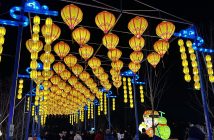
Temple fairs were historically related to the religious activities of temples. Gradually temple fairs have become more about shopping and entertainment, and religious activities have become less important. Temple fairs in Beijing have a long history, and the fairs that take place during Chinese New Year and Spring Festival, will try and reproduce the traditional customs of Beijing. Entertainment often includes many kinds of Chinese folk art such as music, dance, theater, acrobatics, and arts and crafts. A temple fair is also where you can taste numerous Chinese New Year foods and snacks. Dulwich College Beijing (DCB), together with Beijing Riviera Country Club, hosted the Shunyi Temple Fair on Saturday February 7. This year, the event focused very much on the traditional and cultural elements of Chinese New Year celebrations, embracing everything from lion dance to candied haws.
In winter, on the streets and alleyways of old Beijing, vendors would call out, “Candied haws, candied haws…” and Spring Festival is the best time for selling candied haws (糖葫芦 tánghúlu) . From the first to the fifteenth of the first lunar month, people will crowd to the temple fairs, where candied haws can be seen everywhere. Shunyi Temple Fair had its very own vendor, handing out candied haws to all the kids. My daughter loves them, and managed to persuade the vendor to part with two sticks just for her. The traditional method of making candied haws is to string wild fruits on bamboo sticks and then dip them in malt syrup. The malt syrup turns hard as soon as it is exposed to the air, creating the crispy and sweet sugar-coated haws. The wild fruits used are mostly haws, or the very similar fruit crabapples, creating a wonderful taste contrast of sour and sweet.

There were several traditional Beijing snacks that we tried at the Shunyi Temple Fair, including pea flour cake (豌豆黄 Wāndòu huáng) which is yellow in color and tastes like solidified split pea soup. Formed into a soft brick, I wouldn’t say it was terrible, just not something I would hanker for as a snack. Steamed glutinous rice cakes, with a sweet filling (艾窝窝 Ài wǒ wǒ) were actually quite nice. My kids liked the taste of the rolling donkey (驴打滚 Lú dǎgǔn), a pastry made of steamed glutinous millet flour or soy bean flour mixed with sugar, which is then rolled and covered in a soybean flour crumble. Traditional Beijing snacks are an acquired taste, but as they’re inexpensive to buy it’s worth giving them a try.

The striking of the gong announced the imminent arrival of the lions. Lion dance (舞獅 Wǔshī) is a form of traditional dance in Chinese and other Asian cultures, in which performers mimic a lion’s movements in a lion costume. The lion is operated by two dancers, whose faces are only seen occasionally. The loud drumming and the acrobatics of the lions captured the attention of every child and adult, as a flurry of yellow and gold fur performed some incredible moves for us. The fundamental movements of lion dance can be found in most Chinese martial arts, and has close relations to kung fu or Wǔshù (武術). The dancers are usually from a martial arts club or school, practicing and training hard to master the skills. In China, if a school has a capable troupe with many ‘lions’, it demonstrates the success of the school.

The kids had plenty to keep them occupied once the lions had performed. Art and craft activities included Chinese paper cutting, lantern making, and Chinese knots. Activities were suitable for all ages, with all materials provided, so the kids could be as creative and decorative as they wished. On sale were tiny Chinese zodiac animals made from dough and encased in a glass dome. You could buy pinwheels, stuffed toys, and blown candy. An old-time skilled art form still alive in Beijing is that of artists blowing sugar and forming it into one of 12 zodiac animals, for young children to play with and eat. These Chinese street artists are a dying breed, but their skills are quite spectacular to watch, as they can form a rather accurate recreation of an animal in a couple of minutes using nothing more than their mouth, hands, and some melted sugar. The resulting zodiac animal is attached to a wooden stick, and then decorated with colored dye, to make a piece of beautiful traditional art.
DCB did well to embrace the spirit and culture of traditional Beijing temple fairs, with plenty for the kids to see and do, and a chance to learn more about Chinese New Year. 2015 is the Year of the Sheep, although you will also see it referred to as the Year of the Goat, and even the Year of the Ram. In Chinese they use the same general term yáng for these animals. Our family has long been fans of Shaun the Sheep, so it was both original and great fun having your photo taken with a giant Shaun at the temple fair.
beijingkids Shunyi Correspondent Sally Wilson moved to Beijing in 2010 from the UK with her husband and son. Her daughter was born here in 2011 and both her kids keep her happily busy. In her spare time, Sally loves to stroll through Beijing’s hutongs and parks. She is a (most of the time) keen runner and loves reading: books, magazines, news, and celeb websites – anything really. Sally is also a bit of a foodie and loves trying out new restaurants.
Photos: Stephanie Koh (Flickr), Nate Gray (Flickr), Sally Wilson



